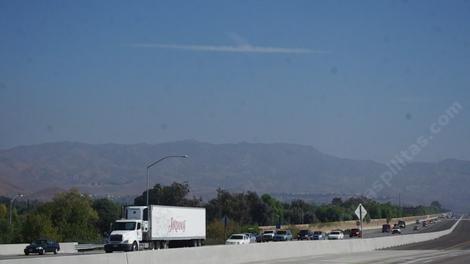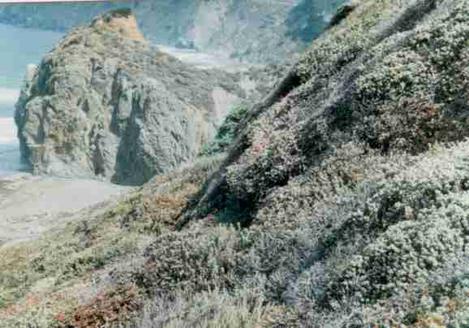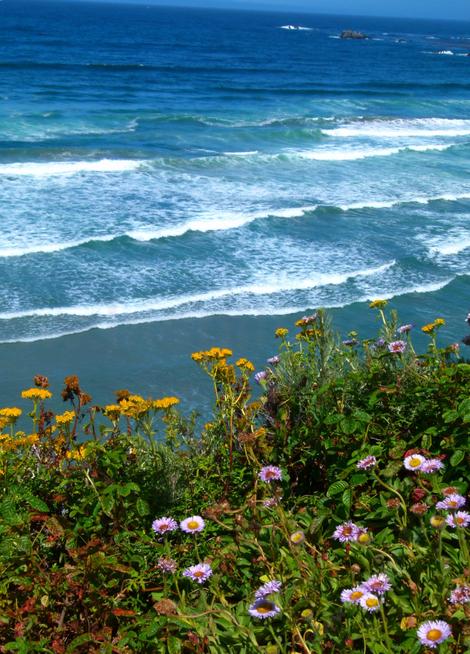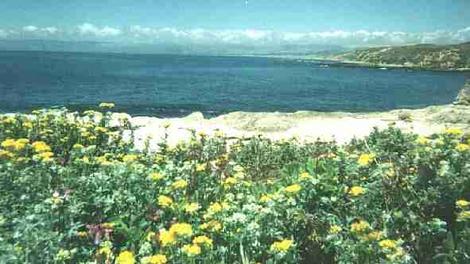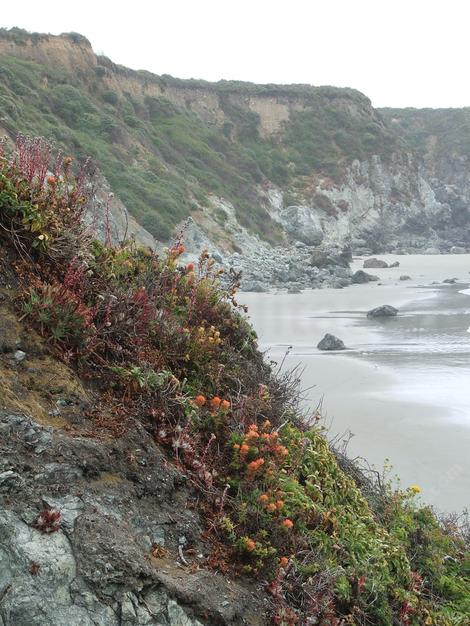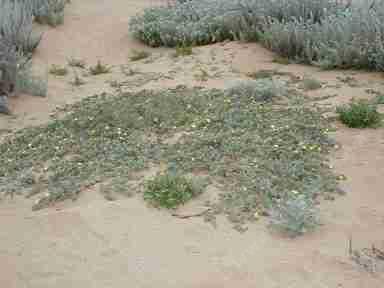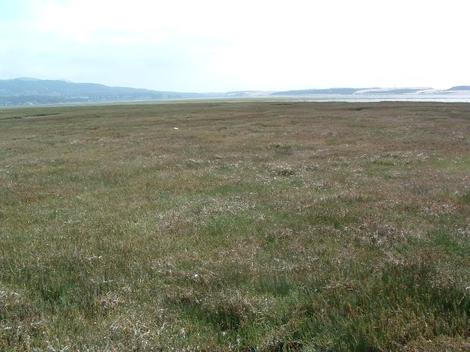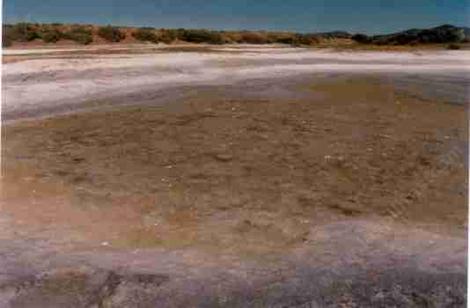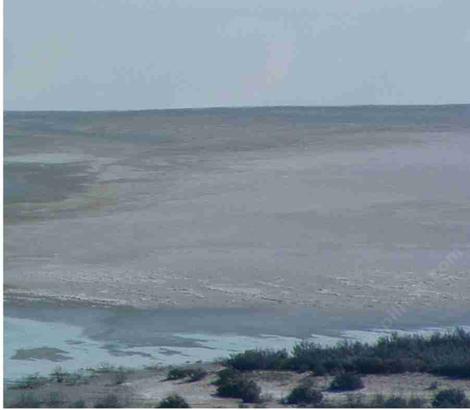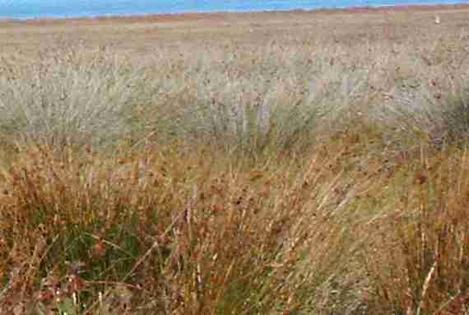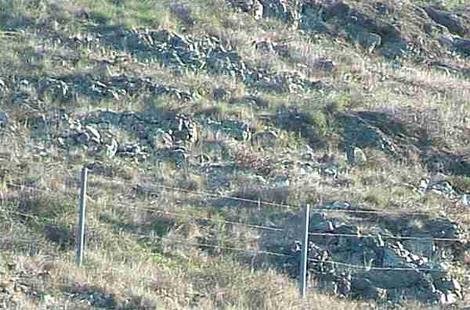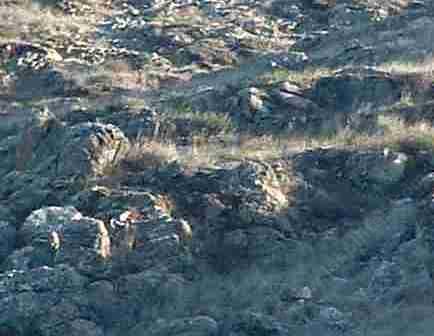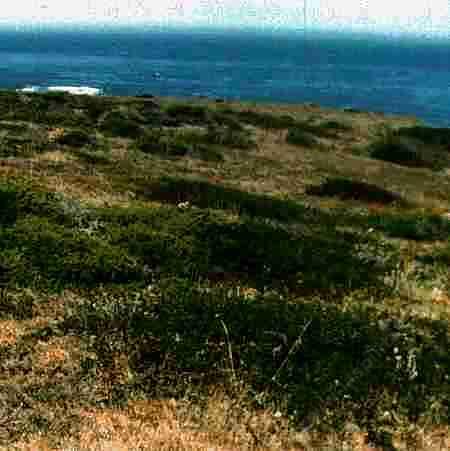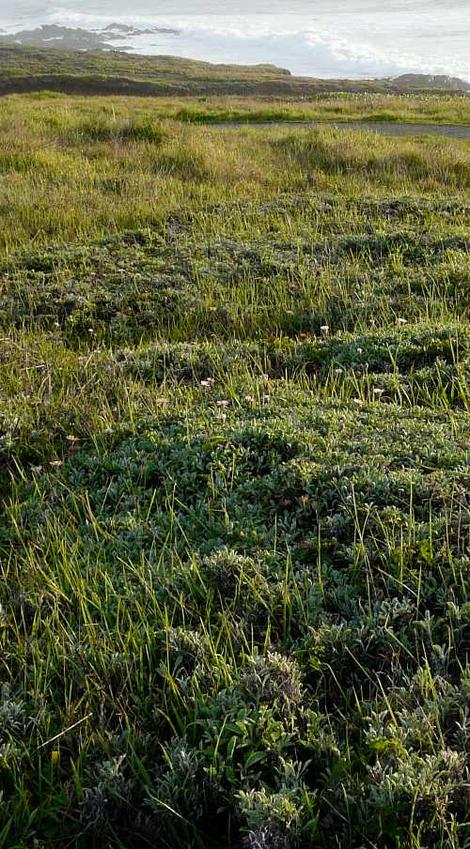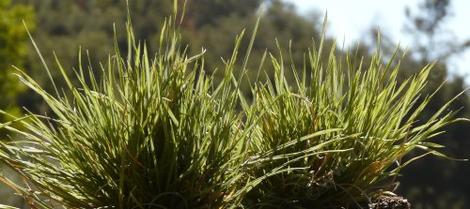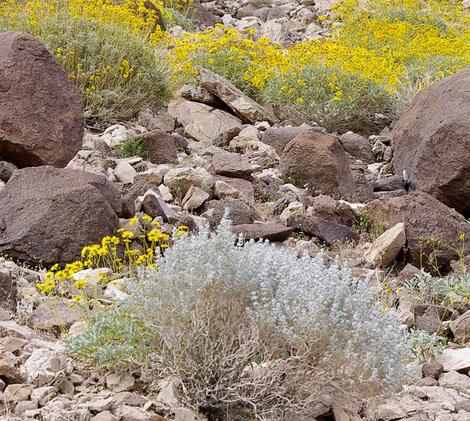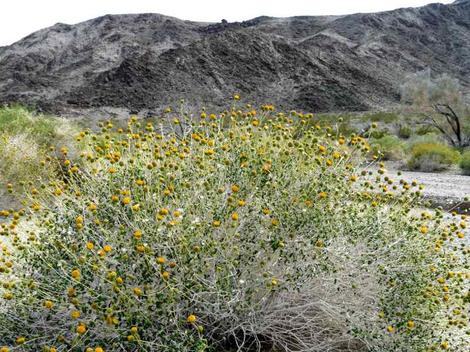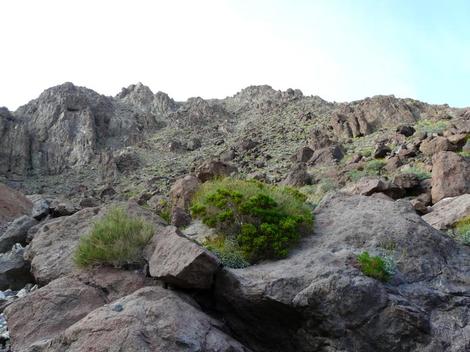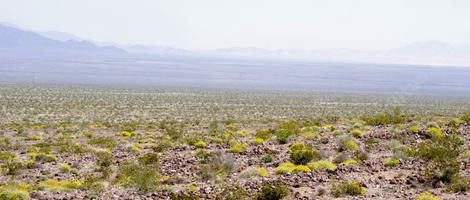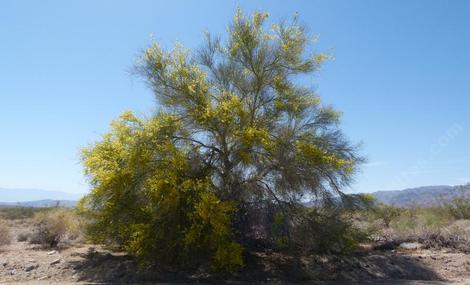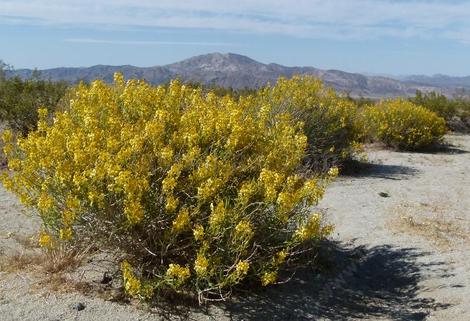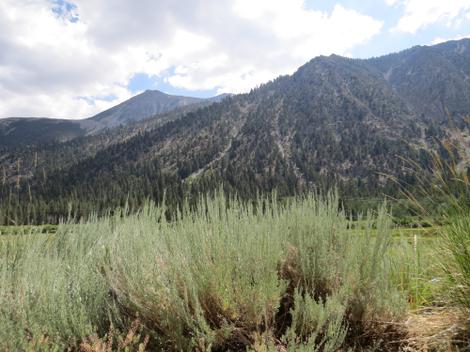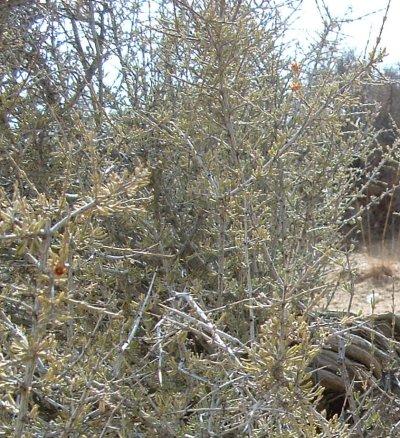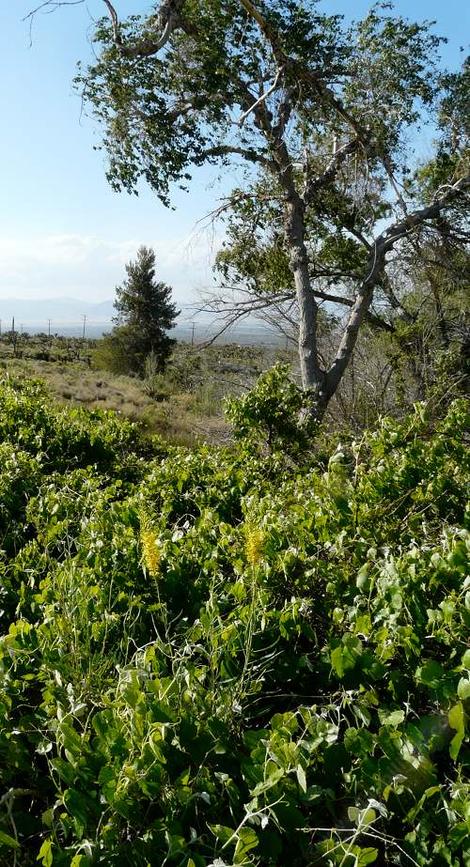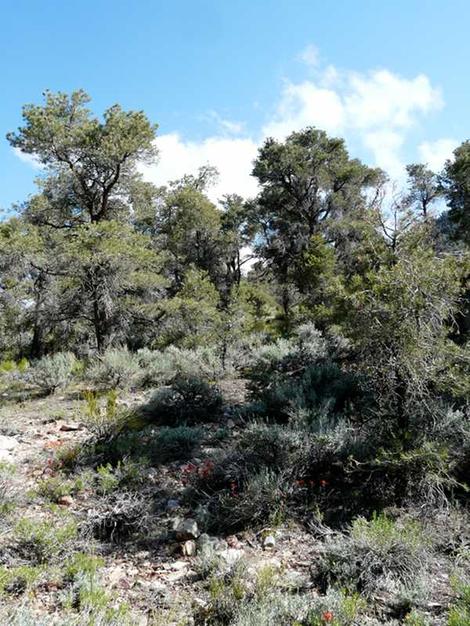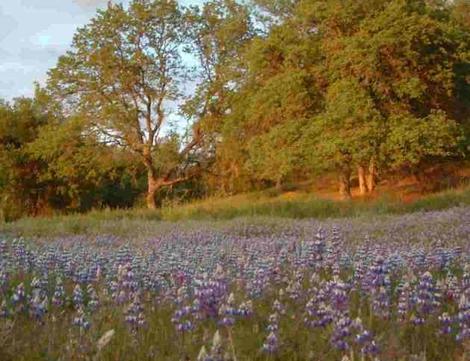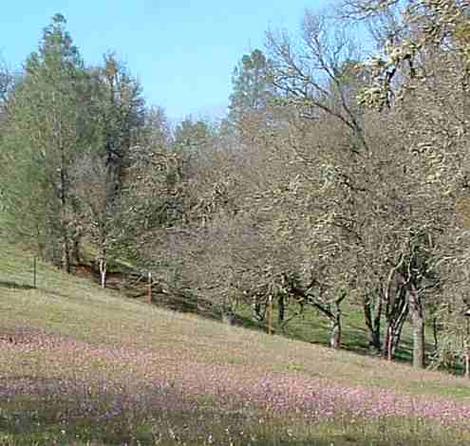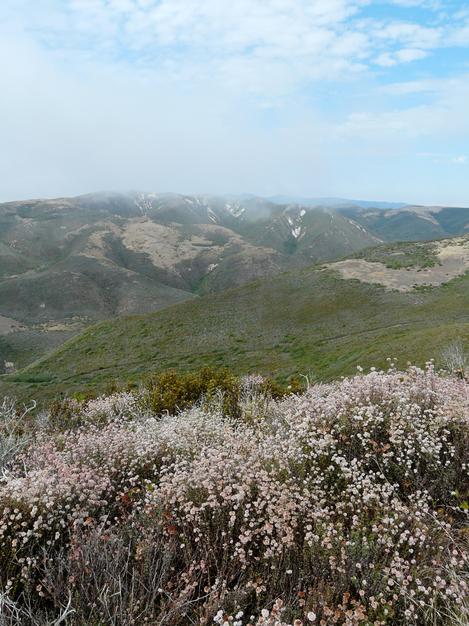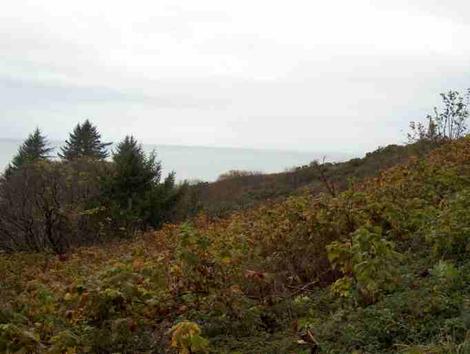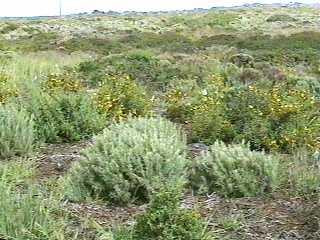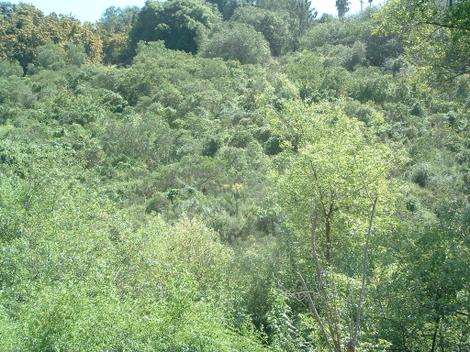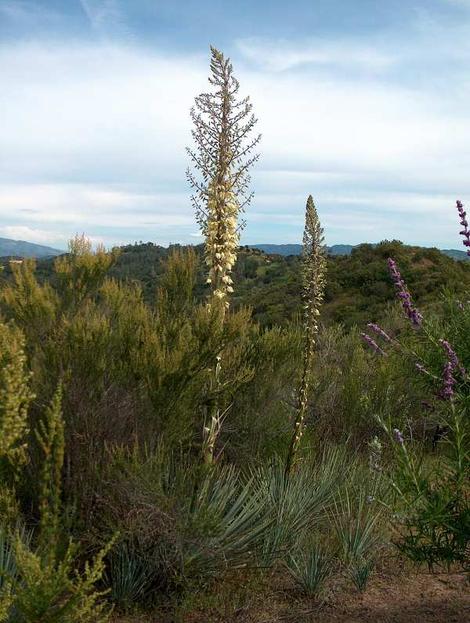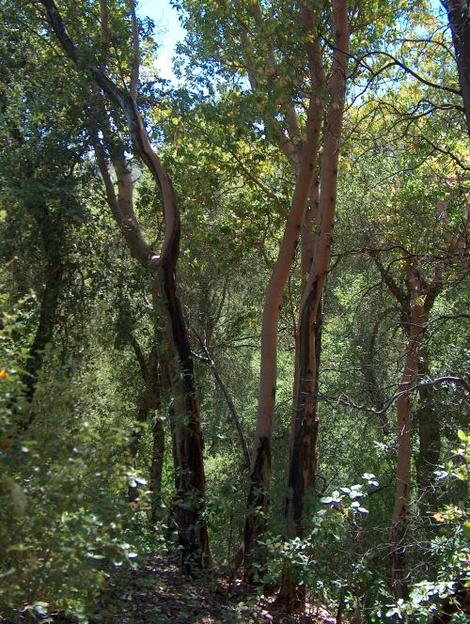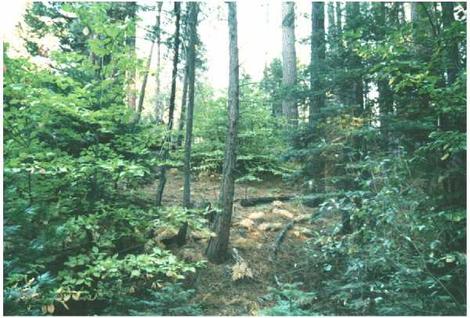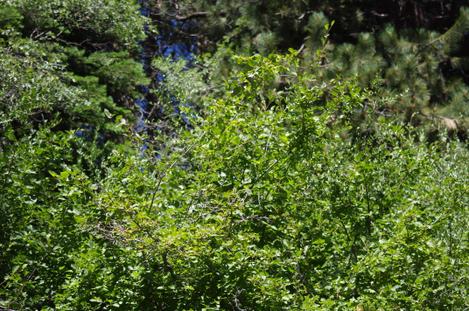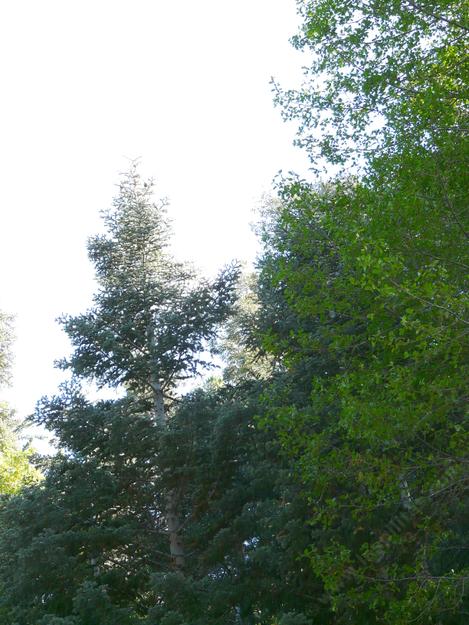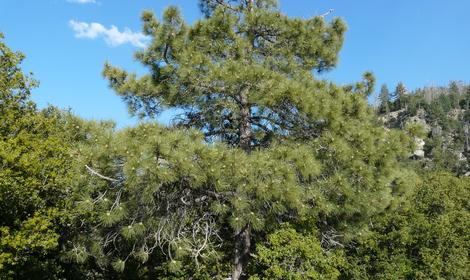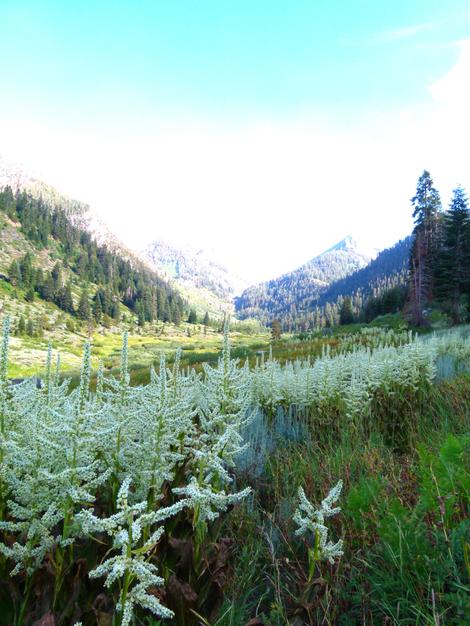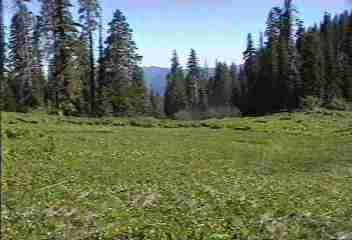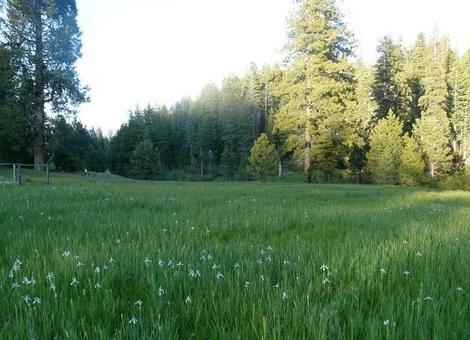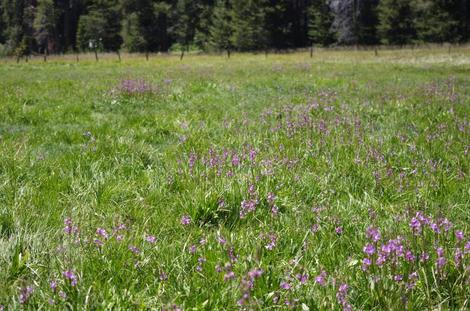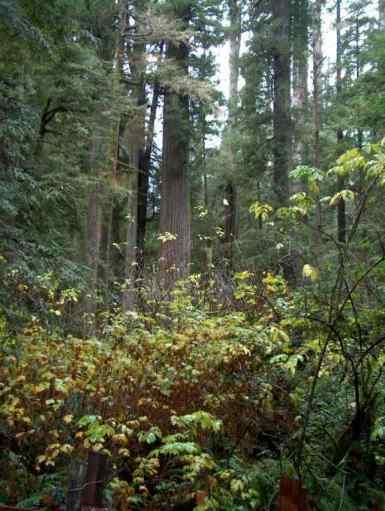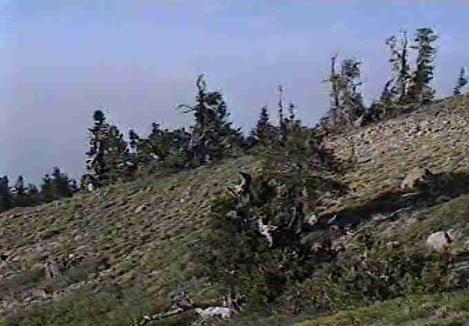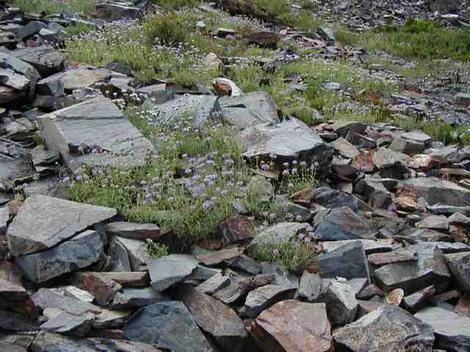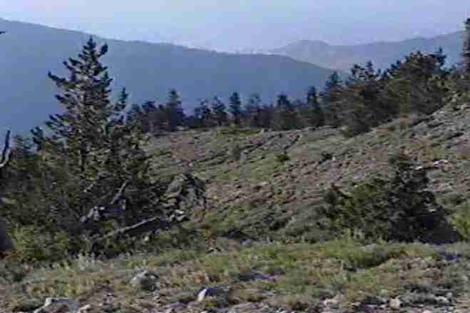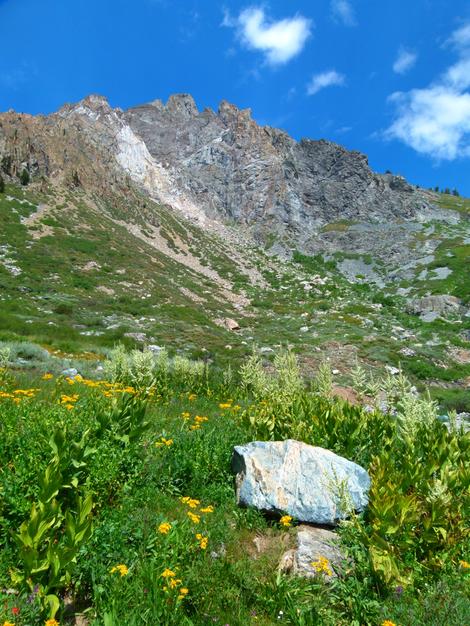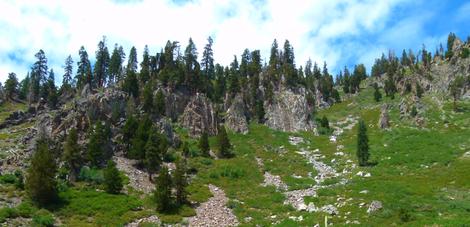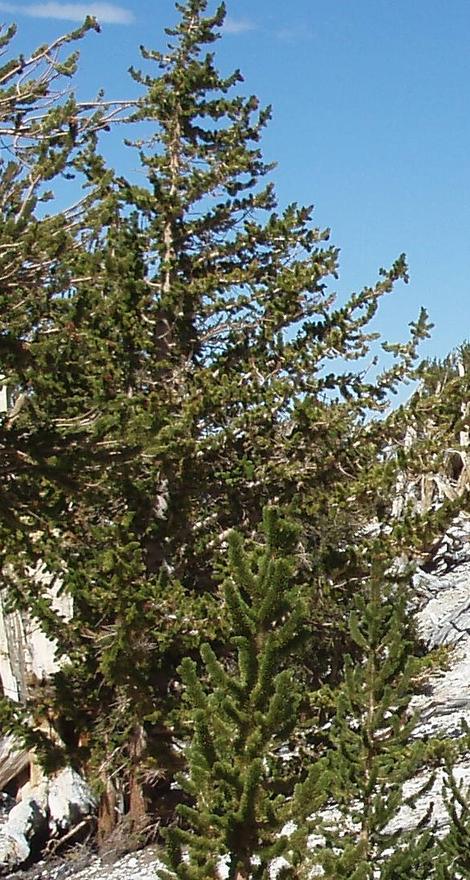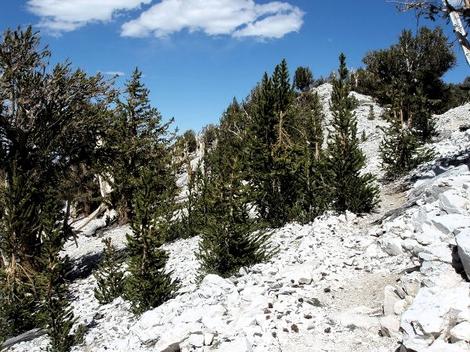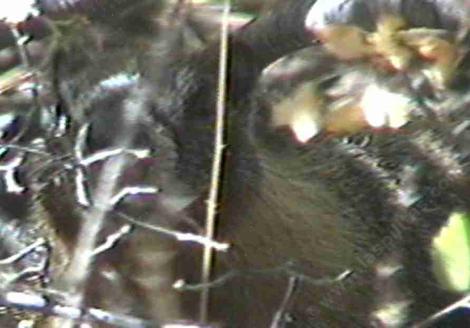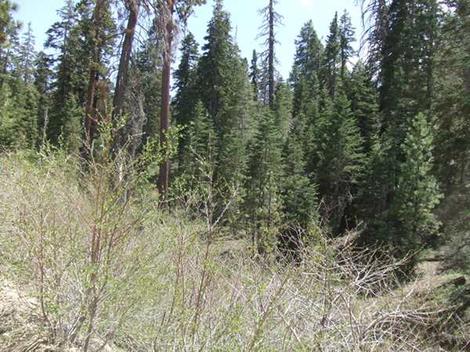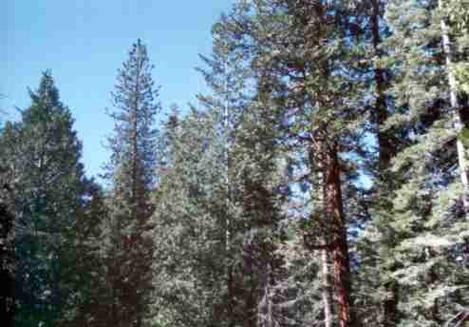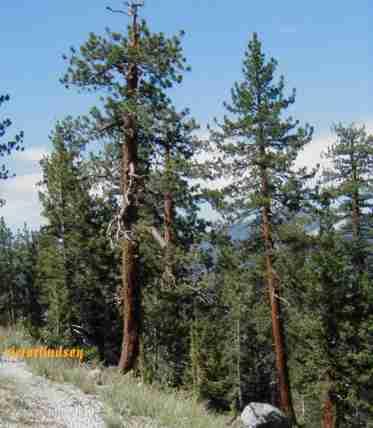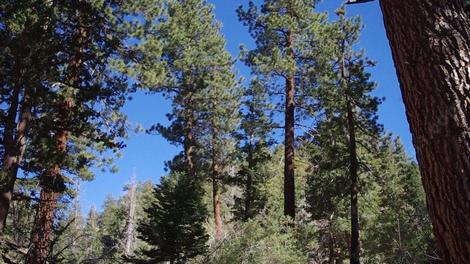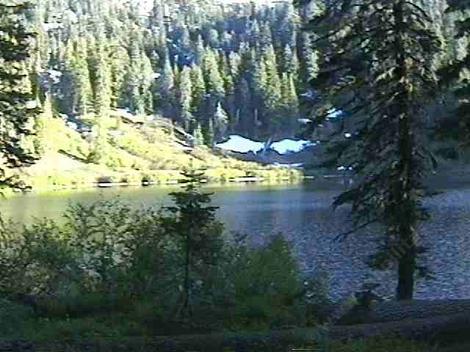Native Plant Habitats of California
Habitat, niche, plant community, biome, ecotone, and ecosystem are different ways of attempting to define a group of plants and their associated situation(s)(plants,animals, insects, non-living, etc.), sometimes habitat is used incorrectly as a synonym for niche, sometimes as a synonym for biome, we're using habitat as the step above community but below biome, where a set of unrelated plants inhabit the same situation over multiple plant communities. In many areas of the state it is difficult to define which plant community is on a site, as the plants from several plant communities intermingle together along the ecotones (the areas where plant communities overlap or merge). Other areas of the state are so trashed that only one or two native plant species are left, and they exist in two or three plant communities.
The wildlife generally see habitat as we define it, and a plant community is part of the area they use. Some of the birds and butterflies may summer in one plant community, winter in another plant community, but never leave the habitat.
(Some non-California habitats have been included for the other folks in the world that can't come visit California except via the web. )
Coastal Strand
Coastal Strand Rainfall 38-90 cm, high humidityCoastal strand is the area just above sea level that gets daily salt spray, is generally pure beach sand and has adequate moisture for plant growth at a depth of 1-2 feet(.5 meters).
These sites usually are unstable dunes or beach sand with
low-growing plants growing on little mounds where the wind
exposes them, in little clumps of village type communities
where they can provide each other more protection from the
wind and the salt spray.
Where does the habitat occur?
Coastal strand occurs worldwide along the ocean margins. Common plants include Artemisia, Lupinus, Abronia, Atriplex, Fragaria, Mesembryanthemum and Haplopappus.
Why does the habitat occur?
Salt is the main problem in this habitat. The species that have adapted to this habitat have alternate methods for filtering salt out, shielding themselves from salt spray and mining water without accumulating salt. This habitat occurs from the high tide line up over the first dune or two. As the dunes are stabilized by plants they gradually change into brush lands or forest. If the dunes are destabilized the sea moves further inland.
Many of our coastal cities have converted the coastal
strand portion of their city into coastal scrub (Brush) or
Closed-Cone Pine Forests(Conifer Forest). If the site is one
of these conversions it is no longer a strand community.
This community is like a reverse desert. The plants have
access to adequate moisture , along with high humidity, but the salt
spray is very desiccating. Continuous sand blasting with salt.
When should you plant?
Preferred planting time in the west is early spring. Salt content in the soil is low and there are enough rain showers to water the plants in. Worst planting times are late summer and fall. The salt content that builds up during the summer can be lethal to new plants.
How to plant:
1. As long as you use species from the habitat that are hardened off before planting, establishment is poor to good(30-70%). Luck has to be with you to get 95% establishment, but it is very possible. If success is less than 25% something is wrong.
2. Adding soil amendments is detrimental to your plant's growth and establishment.
3. Fertilizer will lead to failure because fertility is not a limiting factor for the plants of the habitat, but is one of the limiting factors for weeds.
4. Watering is negative. After the first or second watering water is no longer a limiting factor for habitat specific species. Water is a very limiting factor for weeds.
5. Moisture is not a limiting factor after the second or third month with seedlings, 2-3 weeks with gallon plants.
6. Organic mulch is not appropriate for this habitat. Boulders are not normally found in this habitat but they make planting a great deal easier and are a definite positive. Plant on the side away from the sea.
Possible problems:
1. Sometimes luck is not with you and a hot period with wind increases salt spray at planting time, the plants will have no tops.
2. Visit the site often enough to understand the winds. Try to avoid working when the site is like something out of a 'Desert Rat' movie. Sand in the face at 30 miles per hour makes life difficult. (Many afternoons are wonderful but plan for the worst and you'll get the best.)
3. Ditches are out in this habitat, they'll fill in before you get done. Look at putting any needed irrigation on the surface or watering the sand before you dig. A one foot deep 'ditch' eight feet wide is a great deal of work and very disruptive.
4. Sharon Rose's electron micrograph shows the coastal strand to be not super community related, but just back from the moisture the plants are very community related. The availability of moisture in the soil and the extreme harshness of the salt spray define this community of individuals more than plant or plant/fungus/animal relationships. Just a few meters inland can often be the difference between shifting priorities, and one of the coastal scrub communities (and the dominance of community over individual) appears.
Alkali Sink/Salt Marsh
Alkali
Sink 3-13 cm rainfall, seasonally moist, high
salt
Mangrove Swamp 300+ rainfall, usually moist, high salt
Coastal Salt Marsh 300+ rainfall, usually moist, high salt
That represents the habitat?
In the lower spots inland from the coastal strand you'll find coastal salt marshes mixed with fresh water marshes. This usually is divided by how far the tides can push into the interior bays and rivers. There are spots in the interior that combine characteristics of salt marshes with alkali sinks. When there is water the sites have the flavor of a salt marsh, when dry they become a vernal pool with high sodium, drying to an alkali sink. The plants that occur associated with these communities are either halophytes or plants that grow, flower and produce seed during the season when the sodium (or calcium) content is lowest. Common plants include Salicornia, Suaeda, Distichlis, Frankenia, Rhizophora(Mangrove) and many Atriplex species.
Where does the habitat occur?
Alkali sinks and salt marshes are world-wide. Most of the plants are cousins of each other worldwide. In California we have Alkali Sinks in many spots of the lower San Joaquin Valley, Soda lake in eastern San Luis Obispo Co., and all those lakes and places in the Mojave, Colorado, and Sonora Deserts that are called 'Alkali Flats', 'Soda Lake', 'Bad Water Valley', 'Dry Lake Bed', 'Buttonwillow' or 'Edwards'. Salt Marshes are mostly at the openings of bays and rivers. In other areas of the world the sea floor is much more shallow and extended so the marsh can exist along the seashore itself. There are a few places that the Salt Marsh is out of place because of runoff from a salty soil. Pismo Beach has one a few miles inland that is not contiguous with the sea.
Why does the habitat occur?
Because of these highly salty waters that flood the planting site the plants have evolved to handle occasional flooding and high salt. Zedler found this flooding was one of the limiting factors for the habitat, and one of the few weed controls that work.
When should you plant?
Spring is best because the salt content is lowest in soil and water.
How to plant:
1. If possible, use divisions from the target site.
2. Grow any plants for the site in a more difficult climate.
3. Water the planting heavily with fresh water at planting time.
4. Mulch is not appropriate for these sites. (One of the local 'restorationists' covered an acre of salt marsh with shredded redwood bark so the 'microrizza' could grow, the mulch floated away on the first high tide.) Mulch is very negative to most halophytic vegetation.
5. Boulders are sometimes OK, according to the site. If there aren't any there, don't add them.
Prairie/Pampas
Grassland
18-90 cm. rainfall, high huidity in winter, low humidity in summer
Pampas Grassland 90-120
Coastal
Prairie 30-90 high humidity, little frost
Mid-West Prairie 52-90
Steppe 30-40
Desert Grassland 20-30
What represents this habitat?
This is a poorly defined and misunderstood habitat within California. In much of the undisturbed prairie the saying 'Where's the beef' could be translated to 'Where's the grass'? The native grass species are seldom in dominance, commonly lacking altogether. Wildflowers are very important in the drier areas of this habitat and add significantly to the moisture/energy acquisition bringing the effective rainfall up as much as 20-30 cm/year. If the site has no remaining wildflowers it will not be easily restorable. In parts of the San Joaquin Valley many of the 'Grassland' areas are actually Shadscale Scrub. In the coastal areas many of the "Prairie" areas are Coastal Sage Scrub. In both coastal and interior areas the trees were removed in the 1700's and 1800's, the perennials were overgrazed in the 1830's-1840's. Many of these sites were wiped out in California in the late 1700's and 1800's when the Missions ran as many as 100,000 cows and 25,000 horses in each valley. The Mission system collapsed in the 1830's and many mission lands and properties were without controls. For many years the cattle and horses ranged free. In the 1840's there was a severe drought in California. (Santa Barbara had no measurable rain in 1841.) In the late 1800's many areas were repeatedly burned by ranchers and miners to clear the land for cattle and gold. In the S. Sierras the fire scars on the oaks show 13 fires in 10 years. Nothing but alien, annual grasses and annual wildflowers can survive such a grazing-burning-grazing regime. Add all these ravages together and you can understand the misidentification of many of the 'Grassland' and 'Prairie' areas.
Where does the habitat occur?
In the Mid-West the Prairie is largely grass with trees only in the lower spots along the creeks and rivers. In the pampas area of S. America the grassland is like some parts of California. There is a mixture of perennials, shrubs and some grass. Common plants include most of the wildflowers that California is famous for; Poppies, ( Eschscholzia ), Baby Blue eyes ( Nemophila ), Phacelias ( and many other members of the Hydrophyllaceae family ) and Lupines. Perennials include Happlopappus, Iris, Brodiaea ( Blue Dicks, Harvest Brodiaea, etc.), Sisyrinchium ( Blue and Yellow- Eyed Grass ), Grindelia and Eriogonum ( Buckwheats ). Grasses include Festucas, Danthonia, Deschampsia and Achnatherum.
Why does this habitat occur?
Basic rules to tell if you have a true grassland/prairie/pampas type community:
1. Does the soil have a sodium, boron or other mineral imbalance? (Serpentine can also cause an imbalance.) Many of the true grasslands occur because monocots(grasses, lilies, bulbs etc.) tolerate boron or other mineral problems.
2. Monocots tolerate seasonal flooding better than dicots.
3. Is the soil shallow and alkaline? Shallow soils in low rainfall areas are generally alkaline. Alkaline soils do not support acid lovers like oaks, pines and manzanitas that grow on shallow acid to mildly alkaline(pH 7.5)soils. Shallow alkaline soils generally support a mixture of forbs and grasses that are very seasonal, often appearing only for a month or so each year when there is enough moisture to support plant growth.
4. Is there a lot of salt spray on a dry site? The primary differences between coastal strand and coastal prairie are the lack of ground moisture during the summer in the prairie. The coastal strand has a very high water table and the plants can extract moisture from the soil. The coastal strand usually sandy, prairie usually heavy clay.
5. Compacted soils also favor a grassland.
When should you plant?
Spring planting is preferred for restoration. All year is no problem for gardeners.
How to plant:
1. Boulders are very useful to provide protection for each plant. Place a 6-12" boulder next to each plant at planting time.
2. If possible saturate the site with water at planting time.
3. We use a pre-emergent herbicide at planting time.
4. Be prepared for weeds( the most important factor, next to watering).
Possible problems:
1. The shallow soils or salt spray mean larger bushes or trees are nearly impossible in exposed sites.
2. There is a strong bias in this habitat against most trees. Conifers are the least likely to work unless the site has already been partially converted into a coastal sage scrub or woodland site.
3. This community is often miscast. Make sure the plant list for the site is right. Coastal prairie generally belongs only on the first 50-100 ft (15-30 m ) from the ocean cliff. 'Grasslands' only exist where nothing else will grow. If there are bushes and trees seeding themselves all over the site, the site is not a grassland. If there are no weeds or anything else on the site, there is a serious excess or deficiency of plant nutrients and the site is almost impossible to plant and is not a grassland.
4. This habitat is one of the most easily invaded by alien species, and one the hardest to protect. With the cyclic opening and closing of gaps by the wildflowers there are plenty of bare spots for the invaders to land. VERY DIFFICULT!
Hot Desert
Shadscale 6-19
cm rainfall, high winter humidity, dry summers
Creosote 13-26
cm, dry, little or no ground freezing
Joshua Tree
20-30 cm, dry, a little cooler in summer, occasional snow
Sonoran Desert 20-30
I've divided the hot desert from the cold desert by ground frost. In the hot desert the ground does not freeze deeper than 1" even when the air temperature is below -10 C (-15F). Both the hot and cold deserts can be hotter than H, summer ground temperatures can commonly be 130 degrees every day for months. The hot desert has hot nights. Palm Springs has had a high of 128 F.(54 C) and a low of 99F( 37C). (Bare feet are not an option!) The hot desert is a wonderful place to visit in the winter. Winter highs are commonly 80F(27C) during the day and 50F(10C) at night. Frost is rare or even unknown, in the lower desert, common in the upper desert. The frosts are short; that is, they last only for minutes to a few hours. In the upper desert dress warmly if you want to go for a winter morning walk or plan on camping out. A dry 24F with a 25 mile/hour wind makes for very cold conditions ( equal to -60F with no wind and sun ). ( A sleeping bag becomes the interior of an icebox and you are the frozen turkey. Many plants can handle the short- duration frosts. This habitat is highly mycorrhizal and community oriented. The last fairly undisturbed sites within this habitat are being 'protected' as you read this. Many sites that were pristine and free of weeds in the early 1960's have been grazed, disked, seeded or otherwise disturbed by man to where there are weeds everywhere and the natives plant community is fragmented and under stress. Many sites in the Mojave in which I walked barefooted as a kid in the late 1950's are now full of alien Bromus spp., other nasty grasses, and alien starthistle (Centaurea spp.), are uncomfortable to walk in now with high- top boots and long pants.
Where does the habitat occur?
The hot desert areas in Calif. range from about Fresno south through the San Joaquin valley, jumping the Tehachapis Mts. into Mojave and extending west into Eastern Santa Barbara, San Luis Obispo, and Ventura Co.. Some species like Eriogonum fasc. polifolium ( Desert Buckwheat ) or Atriplex polycarpa ( Saltbush ) extend from Central Calif. into Arizona and Nevada. Others like Snakeweed ( Gutierrezia ) and Atriplex canescens extend from coastal California through both the cold and hot deserts up into Alberta and into Texas. . The classic representative for this climate is Larrea tridentata ( Creosote Bush).
Why does this habitat occur?
It is too hot and dry for anything other than these" heat and drought-tolerators". The plants that thrive in the hot desert have evolved to pick up water at the first drop. One study found desert plants picking up water within minutes of the rain shower, coming out of dormancy and producing carbohydrates through photosynthesis within 30 minutes. I'd dare to see most of you out of bed, eating, commuting and having your first report out of the computer in 30 minutes each morning!
The spines on a cactus are there to break up the wind, to reflect sunlight and to protect itself. The waxy coat on a cactus helps to keep the water inside the plant. The cactus ( and other species) takes in sunlight during the day and CO2 at night so it doesn't have to 'breathe' during the hot, dry day.
When to plant:
Winter planting is far easier than summer planting. Summer planting is OK as long as the plants come from a nursery that has stock that is grown in full sun in an interior location ( summer temperatures of 90F or above.) Stock from coastal nurseries has a tendency to look like it has been in a convection oven after a few minutes to hours.
How to plant.
1. Dig a hole and set the plant in it..
2. A boulder or rock is very much needed next to each plant. Plant on the north-east side of the rock.
3. If possible, water once every week or two for the first few months after planting drought tolerant desert species. Conventional yards need more. Lawns are happy at 1/week for Bermuda grass, 2/week for tall fescue.
4. Do not use fertilizer or amendments unless you are planting a winter vegetable garden.
5. A product called DRY Water seems to be ok to use at planting.
Possible problems:
1. If you're overwatering your site, the desert plants around you are dying.
Cold Desert
18-31 cm rainfall, think dry summer breezes and winter wind chillSimilar to the hot desert but has higher daily temperature swings and colder nights. An unprotected sleeping bag in this climate can kill you on a bad winter night. Temperatures can run from a summer high of 110 F ( 44 C ) to a winter low of -30 F ( -35 C ). Sometimes these extremes are only 30 days apart. This climate is very volatile and unpredictable. The ground commonly freezes to 12 inches, sometimes to 4 ft. ( 30-120 cm ). 'Spring' may last for 2 weeks after a winter rain and before a hot summer day.
Where does this habitat occur?
In N. America the cold desert occurs from about Lone Pine ( Calif ) to Central Idaho, parts of E. Washington, W. Wyoming through both Nevada and Utah into N. Arizona and N. New Mexico.
The common plants of the areas include Cowania mexicana var. Stansburiana ( Cliff Rose ), Artemisia tridentata ( and all the different forms and cousins ), Chrysothamnus albidus ( a form of Rabbit Brush ), Salvia Dorrii ( Desert Sage ), Grayia spinosa ( Hop Sage ), Eurotia lanata ( Winter Fat ), and Sarcobatus vermiculatus ( Greasewood ).
Why does the habitat occur?
Low rainfall, dry wind. Desiccating dry cold in winter. The ground can be frozen while the day is sunny and relatively warm. Soil pH varies from neutral to moderate alkalinity.
When should you plant?
Late spring and summer planting is preferred. Winter planting is very iffy. Expect the winter winds to burn the foliage right off. Fall planting is expected to be a disaster. Your plants will push new growth after planting, frost will come and kill your plants.
How to plant:
1. Large rock or boulder mulch is mandatory on all native or drought tolerant plantings.
2. Soil amendments and fertilizers are not needed for any plantings except winter vegetables.
3. For conventional gardens, water extra in spring and early summer.
Possible problems:
1. If you overwater in an area that interfaces with wildland, deer, squirrels, rats and many other critters will love you and your salad.
2. Respect the climate. You can grow a number of difficult species from other areas,(like some fruit trees) but only if you prepare for the temperature extremes. In winter have row covers, sprinklers, heaters etc. that can help on hand.
Rivers and Ponds
Fresh Water
Marsh 300+ cm rainfall, always wet, high humidity
Riparian 300+ cm rainfall, usually wet, high humidity
Pond Plants 300+ cm rainfall, always wet, high humidity
When you're driving around look at creeks, streams, rivers, ponds, etc. . This habitat is the first few feet away from the water. In the shallow shoals along rivers this habitat may extend for a mile or more.
Where does the habitat occur?
World-wide you will always find the same type of plants next to water.
This is the habitat that most of the cultivated plants have come from. Some plants like Rushes(Juncus) and Sedges(Carex) are circumpolar along the wet areas. Plants that are considered drought tolerant in the horticultural trades commonly come from this habitat (Oleander, Star Jasmine, Gladiolus, Russian Olive, etc.)
When should you plant?
Anytime.
How to plant:
1. These habitats are very fertile. No fertilizer is needed.
2. Plants from this habitat need water. Some (as the ones above) can become drought tolerant with work, but look bad or dead at the level of drought commonly experienced in most of the West. Most vegetables and many of the fruit trees come from streamsides. It is very important, if you create one of these habitats, to use transitional plants between these watered areas ( rivers, ponds, lawns, vegetable gardens, English flower gardens, ) and dry areas. ( Between a lawn and a dry slope, between a lawn and an oak tree, between a veggie garden and a dryland garden )
Below is a list of transitional plants that can be used between these wet habitats and the dry areas. Look at your individual site or an adjacent area.
Natives:
Cercis Redbud
Cercocarpus Mountain Mahogany
Chilopsis (in desert gardens only)
Cornus Dogwoods
Fraxinus Ash
Juglans Walnut
Malus Crab apple
Myrica Wax Myrtle
Populus Cottonwood
Prunus Cherry, Plum
Rhamnus Coffeeberry, Redberry
Rhus Poison Oak, Squaw Bush, Sugar Bush
Ribes Currants, Gooseberry
Rosa Roses(wild preferred, hybrid ok)
Salix Willow
Sambucus Elderberry
Non-natives that can do the same thing
Acacia Fruit trees
Ilex(Holly)
Melaleuca Roses
Sunroses
Thyme Ulmus (Elm)
Possible problems:
1. Weeds, weeds and more weeds. You haven't seen weeds until you try to plant a stream bank. TEN crops in one season are possible in some mild areas. Don't you wish weeds were worth something?
2. Riparian habitats are largely populated by ruderal plants. Ruderals have little or no protection from insects, herbivores or drought. Herbivores come to drink and eat, plant on it!
Woodlands
In the west we have many forms of woodlands from Oak, Pine to Juniper.Northern
Juniper Woodland 20-35 cm. rainfall dry, winter and summer
Pinyon-Juniper 20-35 cm dry, winter and summer
North Oak
Woodland 40-100 cm dry summers
Central Oak Woodland 30-60 cm dry summers
The habitat is always mottled, consisting of a mix of trees with fingers and palms of open areas containing wildflowers and perennials. The woodland climate has a definite winter and summer. There needs to be a period of extended drought. The driest of these woodlands never has wet soil. In the middle of the rainy period the soil is dusty. The wettest of these woodlands has a summer that rarely exceeds 90 degrees F.(32 C.) and the dry period is not all that dry.
Where does the habitat occur?
One form exists in Northern California and Southern Oregon with the Quercus garryana (Oregon Oak). Both the coast ranges and the Sierras have woodlands of Pinus sabiniana ( Digger Pine ) and Quercus (many species: Coast Live, Live, Valley, Blue, etc). In many places (the Trans Ca. Range above L.A. and below the Sierras, parts of Arizona and New Mexico) the oaks grow with pines (largely Pinus monophylla) and junipers. These are very diverse communities with a mixture of plant types configured together like drops of oil on water. Make sure the trees and their associates are together, with most of the perennials going in the openings between the groups of trees. The ground is commonly bare of plants under the trees, but has a 1"+ layer of mulch. You can use annual grasses and weeds as indicators of how clean and vital the site is. These sites have very strong suppression of alien species when the communities are 'alive'. Wildflowers in spring, bare ground in summer, light mulch under the trees.
Some areas where the Chaparral, Joshua Woodland, even Coastal Scrub interface with the woodland can be confusing as one community morphs into another. You can't find a line in the sand that marks one community or the other, one habitat or another, but patterns with which that you can usually declare the larger areas one or the other.
When should you plant?
Spring is the preferred planting time. Early fall planting usually feeds the wildlife if they are present. Winter planting is easy as long as the plants are hardened off (preferably dormant) and are hardy. Summer planting is easy if no wildlife are present and you can water until the winter rains. Late fall planting is difficult even in a downtown yard because the new growth gets killed by frost.
How to plant:
1. If planting between the trees, watering is ok if the type of plant needs it.
2. If planting under the trees avoid plants that need water or fertilizer. Try to plant plants that are associated with the trees in your area.
3. If planting in the open you can use chipped wood or rocks as mulch for the plants that need it.
4. If planting under the trees organic mulch like chipped wood is needed.
5. Do not plant a lawn under the trees. This is like planting a freshwater marsh next to this habitat ( Remember, transitional plants go between the marsh and the oaks ). You'll not find many oaks or junipers growing in the middle of a marsh.
6. Do not amend the soil near the trees unless you want to kill the trees ( Slowly but surely). In this habitat it is very important not to dig ditches under the trees or between trees. Most of the tree species and larger shrub species in the habitat have ½ of their roots in the top 2 ft. of soil. These upper roots provide the immune system and nutrition reservoir for the key plants and should be protected.
Brush
Northern
Coastal Sage Scrub 90-180 cm rainfall
Shrub Acidic (Europe) 50-90 cm
East Australian Scrub (Health) 35-90 cm
W. Australian Scrub 40-60 cm
S. Africa heath(Fynbos) 35-90 cm
Shrub Basic(Europe) 40-64 cm
What represents this habitat?
The trees are small or limited to the north slopes and riparian areas.
Little or no open areas. The brush covers the hillside at a height of 5-10 ft..
This habitat is commonly the precursor for the woodland communities. If fire is suppressed for 300-500 plus years the site can become a woodland. (The trees will establish in the deeper soil areas.) If fire is not suppressed and allowed to burn in intervals of less than 30 years you will have a grassland after 3-10 fires. (Savannas tolerate fires well in short intervals, chaparral needs an interval of 70+ (S.Cal.& Arizona) to 500 (N.Cal.) years to be stable.) If your house is in this habitat plan for an inferno. Look at the help file on fire protection, fire chimneys, planting in fire areas. Native plants from the area are actually very effective in stabilizing the slopes and reducing fire susceptibility as long as you know what to do. . These communities are awesome when you get them right. We've clicked some sites in one step from a weedy field to a clean native site that needs no further inputs and the native species from the surrounding areas start seeding themselves back in. Life is easy when these sites are correctly put together. Common plants are Arctostaphylos, Ceanothus, Salvia, Diplacus, Rhamnus, Ribes, etc. in Calif.. In Australia common plants include Grevilleas, Anigozanthos (Kangaroo Paw) and Leptospermum (Teatree). In S. Europe common plants are Cistus, Rosmarinus, Lavandula, and Salvia.
Where does the habitat occur?
This habitat is the most common one in the populated areas of Calif.. Many areas of the state have had the brushlands completely destroyed by aerial seeding, burning and cattle grazing. Most of the hillsides of Los Angeles used to be covered with brush. Now, most are a 'desert' of alien, annual grasses that burn each year. In Australia, S. EUROPE, N. Africa, S. Africa and parts of Chile this habitat is also dominant.
Why does the habitat occur?
This habitat commonly has shallow acidic soils on hardpan. Soil depth is commonly 1-36", reddish in color, and a has a pH of 5-7. Some sites have acidic clays that are reddish brown to bright red, others are sandy and varying in color from red through white into black. Soils are waterlogged in winter, dusty dry and hard in summer. The shallow, acid soils favor brush over grass or trees.
Then there a some areas of heavy chaparral in Southern California that have clay soil and a pH of 7.8... just to make things hard.
When to plant:
Planting ease is in this order: spring is easiest, then early summer, late winter, summer, winter and fall. If there are no deer or other herbivores to eat your plants fall moves into the space between early summer and late winter.
How to plant:
1. Mulch is mandatory for all drought tolerants. Organic mulch mixed (on the surface, not worked in) with boulders is usually best but organic mulch or rocks and boulders also work.Good mulch like oak or pine chips is great. Lawn clippings, compost, etc. is BAD.
2. Water and fertilizer has a profound effect on this habitat. If your site interfaces with a wildland area water or fertilizer can have a negative effect for a kilometer (500 yards) into the wildlands. The people often critical of the appearance of 'brush' are the ones that are killing it with fertility and water while they're dumping their weeds and trash in it. A little extra water in spring is ok. Washing the foliage off regularly is also ok. Leach lines, septic tanks, pool water, runoff from lawns or parking areas are all deadly to a brushland. Seeding with anything other than site-specific, pioneer wildflowers (true ones, not lawn in a can) is very detrimental to the health of this ecosystem.
3. Thinning the vegetation on an existing hillside and mulching is better by far than removing all vegetation and replacing it with iceplant or grass.
4. With the shallow soils that brushlands live on it is best to stay with brush type plants. The root systems of these species are very specialized; they literally help to hold the hillsides together and are able to wring much more water and nutrition from the soil than the average plant. Pick the best ones from your area and work as much as possible with those.
Possible problems:
1. If you plant shallow- rooted plants and overwater, you slide down the hill.
2. Fire.
Brush is usually fire adapted and needs a fire every hundred or two hundred years to restart. Weeds that have followed man have made the situation much worse and some areas burn every year as the brush is replaced by weeds and houses.Temperate-Mixed Forest
Temperate Forest 80-150 cm rainfall
Mixed
Evergreen Forest 80-150 cm
Eastern Hardwood Forest 100-200 cm
What represents the habitat?
This is a combo forest where conifers, evergreens and deciduous trees are commonly mixed up in what appears to be a random pattern but is really an intricate web. This is a very lovely habitat to plant in. The cottage effect is easy to achieve. Most of the sites look like Little Red Riding Hoods' Grandmother's house in the woods. The undergrowth is sometimes merged with the shrubs, small trees and larger trees into one large wall. You can thin the undergrowth and replace some with mulch. For fire reasons it is important to open up around structures so that the tree canopy is no longer touching (see the help file on fire, etc.). We usually thin out the firebombs like Poison oak (ivy) leaving it between the house and the neighbors but away from structures, replacing it with other plants from the community such as Rhamnus, Ribes, Cornus, Cercis, etc. This habitat is very mellow if you live on a slope under the trees. It is cold and moist if you live in the valley floor. It is dry and difficult if you live on a ridge or you cut all the trees down. You can water in this habitat but it is best that you recognize the dry season of the community and respect it. Common trees are Acer (Maples), Quercus (Evergreen Oaks), Fagus (Beech), Ulmus (Elm), Carya (Hickory), and Fraxinus (Ash).
Where does the habitat occur?
In California and the west this habitat occurs in moderate to high rainfall areas commonly in elevations of 1000-4000 ft. (300-1200 m). The forests of the East coast and parts of China are temperate-mixed forest.
Why does this habitat occur?
Regular quantities of rainfall combined with a mild to moderate climate and good to fair soils make for a lush full forest. 'Drought' does not really occur. (These people complain when it rains only 30 inches(75 cm) or there is a break in the rain longer than a few months.)
When to plant:
Planting ease is in this order: spring is easiest, then early summer, late winter, summer, winter, fall. If there are no deer or other herbivores to eat your plants fall moves to the space between early summer and late winter.
How to plant:
1. There are patterns to the forests. The areas with conifers and oaks hate fertility and extra summer water. The rest of the forest can tolerate fertility and water. Plant the vegetable garden or lawn away from the conifers, oaks, madrones and manzanitas with transitional plants placed between those two areas.
2. Fertility is marginal for lawns and flower gardens. Soil amendments are acceptable only with the limitations of #1.
3. Remove as few trees as possible to make your garden. Remember the ecosystem is interlinked. Look at the trees as pillars in an ancient Roman building. A few can be removed but more than a few and the building collapses.
4. Be careful with the sprinkler, power, sewer and telephone lines. Each line can cut the forest up into pieces.
5. Weed control is a must. Attack your enemies!!! Die weed, Die!!! If you're aggressive for the first few years your yard will stay clean. Weeds are the biggest problem in most of these sites. Be prepared for the worst.
6. Mulch is mandatory for all drought tolerant or native plantings.
7. If you're planting fruit trees or vegetable gardens they only live in this community along creeks.
Possible problems:
1. Weeds (see help file in weeds)
2. Fire (see help file on fire)
3. Critters (Bears, deer, squirrels, birds and such (moose?)
Meadows
Meadows 200 cm
rainfall high humidity, seasonlly somewhat dry
Bogs 300 cm
Fens 300 cm
What represents the habitat?
These are marshes that are never fully flooded. They are usually dry- appearing until you try to walk across one to examine the flower that is always in the middle. I've lost shoes before, nearly my pants. It's like being stuck on 2-3 ft. deep fly paper. Meadows are common where there are slight depressions in seasonally wet areas. Meadows are commonly associated with snow-fed rivers, creeks or marshes where the water table is a few cm. (an inch or two) lower than the ground. Bogs are acid marshes where the vegetation has grown over the water and created a false soil on top. (These are exciting to walk on.) The easiest separation between these meadows and the marshes ( ( in the Rivers and Ponds habitat) is that in marshes you know you're going to get wet and in meadows you don't know it but you will!
Where does the habitat occur?
Worldwide in the temperate or boreal areas. Many of these habitats are but a few meters across with the next one miles away.
Why does the habitat occur?
1. Water can not drain away (low places), so meadows (seasonally dry on the surface) support different types of plants than bogs (not seasonally dry), whose specialized plants actually grow on the surface of the water
2. Organic matter accumulates because the growth of the specialized bog plants restrict movement of water (water movement mixes oxygen with the water and the bacteria that break down organic matter need that oxygen ) and since water cannot drain away the organic matter that is usually floating in it cannot drain away,
3. Cool to cold temperatures slow the breakdown of organic matter even more.
4. These habitats range from acidic to very acidic because the growing plants in these cool to cold temperatures increase the acidity and in bogs, cause these conditions of minimal water movement.
When should you plant?
Planting is best in late spring, ok in summer.. Difficult in fall. Generally impossible in early spring and winter (because of snowfall).
How to plant?
This community is a no-brainer. You may need snowshoes to plant, but dig a hole, plant at soil level ( in meadow), lightly tamp in with your feet (take off the snowshoes) and monitor for herbivore damage. For bogs, create a depression, always keep wet, lots of peat moss at first placed on top of the soil, plant appropriate plants at edges.
Possible problems:
1. Watch the soil levels. Wet soil can be a couple of feet lower than dry soil. If the plant wants wet, plant in a low spot, if the plant likes drier conditions , in a higher spot.
Rain Forest / Tropical Forest
Very little drought stress. Usually shallow soils with all
the fertility in the top 3-4 ft.(1 m) of soil.
Examples of community.
Africa Rainforest 150-300 cm
rainfall
South American Rainforest 200-300 cm
Southeast Asia Rainforest 150-250 cm
Australian Rainforest 150-200 cm
Where does the habitat occur?
There are cool forms and hot forms. The cool forms are the temperate rainforest. They occur in North America(Coastal Calif. to Alaska) and South America (S.Chile). The hot form is the Tropical rainforests of South America (Amazon Basin), Africa, N.E. Australia, and S.E. Asia.
Why does this habitat occur?
These are good examples of not being able to separate climate, from the plants from the soil. In any of these habitats if the trees are cut down the climate changes, and consequently, the soil won't support the trees and washes away. In parts of the tropical rainforests cleared areas are becoming semi-deserts. The high trees create an environment that catches, collects and creates fogs, extra rainfall and extremely high humidity. Cut the trees down and the rainfall drops, the fogs and humidity disappear and consequently, the microclimate is destroyed. Some of the studies suggest the moisture capture from the tress may be two to three times the actual rainfall.
When should you plant?
No big deal. You can plant at anytime.
How to plant.
1. Water for the first few years. The plants in these habitats take a while to get established.
2. No amendments, no fertilizer unless you are away from the trees in an opening and planting vegetables or a lawn (Don't forget your transitional plants and areas) (See list under Rivers and Ponds habitat).
3. Most of the roots in these forests are in the top few feet. Be careful with your ditches, telephone lines, septic tanks, roads, etc. You can cut the forest up with your ditches and finish it off with your septic system.
4. Drip irrigation really, really doesn't work with these species, rain forest species have a wide and shallow root system (for moisture capture), drip waters intensely and vertically. The plants drown as they die of drought. Mist or spinner type irrigation twice a week is preferred.
Possible Problems:
1. Herbivores will eat your plants faster than you can plant if they are present.
2. The footprint of your site can impact a large area. Control the weeds, and control the water and fertilizer if possible. The nutrient cycle in these forests is very efficient and has no idea what to do with increased fertility.
Arctic/alpine/tundra
Fell-fields
80-100 cm rainfall
Alpine 80-150 cm
Tundra 25-40 cm
IS Cold.
'Summer' is a month or two long and is more like 'spring' to most people. Frost can happen at anytime. The whole habitat hibernates for months each year. Permafrost exists at a few feet at many if not most sites.
Where does the habitat occur?
Every high mountain top. The areas around each pole of the planet.
Why does this habitat occur?
The plants (and animals) do things fast in this habitat. The habitats bloat as they capture ten months of resources during two months in the short spring. It's funny to watch the rodents try to run around in late summer (their fall); the place looks like a fat farm. Plants behave the same way. Lush, flowering plants emerge as the snow clears, growing and flowering like weeds until a hint of a seasonal change. As the soil dries, the plants rapidly go through a process of setting seed (on a good year), hardening off and storing as much energy as possible. This all occurs in 30 days or so. The next 30 to 60 days are spent gradually preparing for the next winter. Most of these species, plant, animal and fungi, have a regimented series of shutdowns for winter. If winter comes too fast, the plants and animals die. If you move many of these species to lower elevations their metabolism becomes confused and they either never go dormant or stay in dormancy, though some adapt to lower elevations. The California natives that are easiest are some Penstemons (Rydbergii and heterodoxus come to mind), Heucheras, and many Eriogonums.
When should you plant?
Spring, early summer. Difficult a risky rest of year.
How do you plant?
1. Boulders are useful in this climate. Boulders moderate the temperature swings each day and night.
Plant on the sunny side of the boulder.
2. Do not amend the soil. Fertility is not an issue on most of these sites. The plants are growing in rock or gravel, ain't no loamy soils above the trees.
3. Water only a few times at most. Water in summer and your plants may be eaten or rot. Indirect watering is usually ok, or area watering if your soil is cool is also ok. Again, as my father in law told my wife, lose the drip.
Possible Problems:
1. Chunky chipmunks are a real problem on these sites. If possible put your planting away from high burrow activity. If they don't eat it they'll dig it up. Usually rodents and rabbits are bigger problems on these sites than deer.
2. Fast storms can sometimes snow you in. Plan before you plant. Park pointed down hill.
Boreal Forest
Bristlecone
Pine 30-40 cm rainfall
Taiga 30-40 cm
Boreal Forest 30-50 cm
What represents this habitat?
A largely stunted forest of slow- growing, long-lived
coniferous trees.
Extreme cold in the winter combined with low rainfall and a
short summer.
Cold. 'Summer' is a month or two long and is more like 'spring' to most people. Frost can happen at anytime. The whole habitat hibernates for months each year. Permafrost exists at a few feet at many if not most sites.
Where does the habitat occur?
Every high mountain top. The areas around each pole of the planet.
Why does this habitat occur?
The plants (and animals) do things fast in this habitat. The habitats bloat as they capture ten months of resources during two months in the short spring. It's funny to watch the rodents try to run around in late summer (their fall); the place looks like a fat farm. Plants behave the same way. Lush, flowering plants emerge as the snow clears, growing and flowering like weeds until a hint of a seasonal change. As the soil dries, the plants rapidly go through a process of setting seed (on a good year), hardening off and storing as much energy as possible. This all occurs in 30 days or so. The next 30 to 60 days are spent gradually preparing for the next winter. Most of these species, plant, animal and fungi, have a regimented series of shutdowns for winter. If winter comes too fast, the plants and animals die. If you move many of these species to lower elevations their metabolism becomes confused and they either never go dormant or stay in dormancy, though some adapt to lower elevations. The California natives that are easiest are some Penstemons (Rydbergii and heterodoxus come to mind), Heucheras, and many Eriogonums.
When should you plant?
Spring, early summer only if you have seasons, all year in cool coastal locations.
How do you plant?
1. Boulders are useful in this climate. Boulders moderate the temperature swings each day and night.
Plant on the sun side of the boulder.
2. Do not amend the soil. Fertility is not an issue on most of these sites. The plants are growing in rock or gravel, ain't no loamy soils above the trees.
3. Water only a few times at most. Water in summer and your plants may be eaten or rot. Indirect watering is usually ok, or area watering if your soil is cool is also ok. Again, as my father in law told my wife, lose the drip.
Possible Problems:
1. Chunky chipmunks are a real problem on these sites. If possible put your planting away from high burrow activity. If they don't eat it they'll dig it up. Usually rodents and rabbits are bigger problems on these sites than deer.
2. Fast storms can sometimes snow you in. Plan before you plant. Park pointed down hill.
Conifer Forest |
|
|
Community |
Rainfall [cm] |
|
50-100 |
|
|
100-150 |
|
|
100-100 |
|
|
90-200 |
|
|
100-230 |
|
|
Loblolly , Slash Pine |
100-200 |
|
Montane Forest |
100-150 |
Where does this habitat occur?
Ringing the N.Pole. In N.America it extends down into central Canada.Why does the habitat occur?
Occasional permafrost, frost at anytime, drought, and the total darkness of the arctic circle, in winter.When should you plant?
Early 'Summer'How to plant:
1. The natives of this habitat are easy; just dig and plant. For vegetables or lawn you'll need to amend and fertilize to have anything acceptable.
2. Ask around. This habitat is unforgiving. If no one has planted the plant before in that area, do not buy 100's of them. In this climate the knowledge of an experienced gardener or landscaper that has lived there for 10-20 years or more (the longer the better) is wonderful and should be accepted. If they pass your tests (look at their work and ask questions), be willing to pay a premium for their assistance.
Possible Problems:
1. Cold.2. If the plants are watered more than a few times they may not have enough time to harden off by winter.
3. Even if you don't water at all, the plants can push new growth and freeze.
Where does the habitat occur?
A forest of pines, firs, larches, spruces, cedars and hemlocks. (Some authors consider members of the Podocarpus and Araucariaceae family to be conifers; for our purposes I don't.)All over the temperate regions of the N.Hemispere. Introduced into many other areas at the expense of the original native flora and fauna.
Why does the habitat occur?
1. Acidic soils with good quantities of seasonal rain.
2. Usually soils are granitic or sandy.
3. Although there is seasonal stress it is manageable within the ecology of the forest. If the heat and drought stress moves beyond these manageable limits the habitat will switch to Temperate Mixed, Brush or Woodland. When should you plant?
Spring is easiest. If little or no herbivores are present fall planting is ok. If the climate is one of the milder ones winter planting is excellent. If you have water and can water, summer planting is fine. In other words, for most plants, in most sites, planting all year is ok as long as you know the pitfalls.
How to plant.
1. Fertility is death to forests. Water moves through these systems and fertilizer can negatively impact large areas of an ecosystem. Be careful where you put the vegetable gardens, lawn, or conventional gardens. Put them away from the trees if at all possible. If your trees start exhibiting high levels of disease and pest problems you're too close. ( Use the transitional plants in areas between the conventional gardens and the trees; see list in the Rivers and Ponds habitat)
2. This habitat has soils of low fertility and moderate to high acidity. To make the items listed in # 1 happy you'll need to amend the soil, add fertility, lime, and water.
3. For species that like your site and need little or no water, dig a hole, and plant.
Possible problems:
If you overindulge your desire to make a "statement" through your garden, you'll kill the forest.The forest has an environmental presence that can suppress and/or kill your 'drought tolerants' if the wrong plants are planted for the habitat. (That's why we have a number of plants on file that are very difficult for you to use.)

